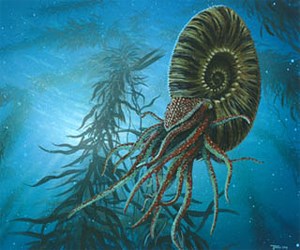Part of a series of articles titled Chaco Collections—Paleontology.
Next: Mosasaur Jaw
Article

Illustration by Lisa Marshall.
Ammonites are an extinct group of mollusk related to living octopus and squid. Complete specimens are often difficult to find, but experts can sometimes identify species with just a small fragment. Ammonites have distinct morphology that varies across species. Paleontologists use physical features such as shape, coil, and ornamentation to identify ammonites and date the stratigraphic layers in which they are found. The remains of over 200 ammonite species have been found on multiple continents. Finding examples of the same species in multiple formations, even if they are miles apart, allows us to correlate those deposits and give them the same time stamp.
Footnotes
The many chambers, or camerae, within ammonite shells are separated by dividing walls called septa, which are visible here. These chambers may have provided structural support to the shell and helped control buoyancy.
After this ammonite died, its soft, squid-like body quickly degraded, but its hard shell remained. Water flowed through the exposed chambers, preserving their shape by filling them with minerals.
Part of a series of articles titled Chaco Collections—Paleontology.
Next: Mosasaur Jaw
Last updated: April 30, 2021